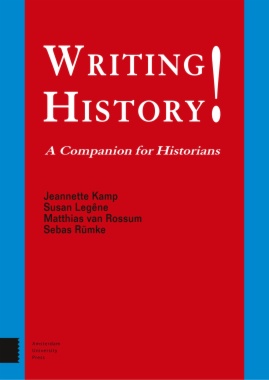Historians not only have knowledge of history, but by writing about it and engaging with other historians from the past and present, they make history themselves. This companion offers young historians clear guidelines for the different phases of historical research; how do you get a good historical question? How do you engage with the literature? How do you work with sources from the past, from archives to imagery and objects, art, or landscapes? What is the influence of digitalisation of the historical craft? Broad in scope, Writing History! also addresses historians’ traditional support of policy makers and their activity in fields of public history, such as museums, the media, and the leisure sector, and offers support for developing the necessary skills for this wide range of professions.
- Contents
- Introduction
- Structure of the book
- 1. Historical research: The importance of the research question
- 1.1 Subject and research question
- 1.1.1 Designating a subject
- 1.1.2 Types of question: Descriptive, explanatory, exploratory
- 1.1.3 The research question
- 1.1.4 Criteria for historical research questions
- 1.2 Orientation and questions: The historiographical context
- 1.2.1 Status quaestionis
- 1.2.2 The availability of sources
- 1.2.3 Your own contribution to writing history
- 1.3 Standpoint and historical debate
- 1.3.1 Criticism and self-criticism
- 1.3.2 Defining your position: Facts, interpretations, and philosophical viewpoints
- 1.4 The research plan: Questions, material and methods, planning
- 1.4.1 Main question, sub-questions, structure
- 1.4.2 Planning and feedback
- 2. The building blocks of the historical method
- 2.1 Primary and secondary sources
- 2.1.1 Primary sources: Originating from the context
- 2.1.2 Secondary sources: Academic historical literature
- 2.2 Finding your way in academic historical literature
- 2.2.1 Literature of all types and lengths: From textbooks to journal articles
- 2.2.2 Search strategies for literature research
- 2.2.3 Looking further
- 2.2.4 Consider your search results
- 2.3 Orientation on primary sources: Can everything be a source?
- 2.3.1 Sources in all shapes and sizes: From text to image and sound
- 2.3.2 Interaction between sources and interpretation
- 2.3.3 Access to collections of sources
- 3. Applying the historical method
- 3.1 Five steps towards a definitive research design
- 3.1.1 After the provisional research question: Reading strategies on three levels
- 3.1.2 Back to the research question
- 3.1.3 Research into sources
- 3.1.4 The importance of source criticism
- 3.2 Organising literature and sources
- 3.2.1 Making a well-founded reading list
- 3.2.2 Making notes
- 3.2.3 Keeping a record of sources
- 3.2.4 Practical tips for saving computer files
- 3.3 Organisation is reasoning: Source criticism and the historical method
- 3.3.1 ‘Silences’ in texts
- 3.3.2 Periodisation
- 3.3.3 Selection
- 3.3.4 Image analysis
- 4. Writing history: Narrative and argument
- 4.1 The structure of a historical text
- 4.1.1 Introduction
- 4.1.2 Introduction and preface
- 4.1.3 The argument
- 4.1.4 The conclusion
- 4.2 Guidelines for the division of paragraphs and sections
- 4.2.1 One paragraph per point or one message per paragraph
- 4.2.2 Examples of organising principles at paragraph level
- 4.2.3 Section, subsection, subheadings
- 4.3 Argument and debate
- 4.3.1 The voice of the author in the historical account
- 4.3.2 The voice of others in the historical account
- 4.3.3 Original work and plagiarism
- 4.3.4 Examples of one’s own argument and references to others
- 4.4 Questions of style
- 4.4.1 Personal pronouns
- 4.4.2 Past and present tenses
- 4.4.3 General and specific statements
- 4.4.4 Rules for annotation
- 5. Presentation and historical debate
- 5.1 Form and style
- 5.1.1 From working paper to poster presentation
- 5.1.2 Presentation styles
- 5.1.3 A few tips and guidelines
- 5.2 Feedback and debate
- 5.2.1 Critique and support
- 6. A historian – Now what?
- 6.1 Professional opportunities
- 6.2 The importance of publishing
- Appendices
- Appendix I
- I.1 Referring to the literature, websites, sources
- I.1.1 Referring to a book
- I.1.2 Referring to an article in a journal
- I.1.3 Referring to an article in a collection
- I.1.4 Referring to a website or digitally available source
- I.1.5 Referring to an archival item
- I.1.6 Referring to a newspaper article
- I.1.7 Referring to an unpublished article or paper
- I.1.8 Notes to visual sources
- I.1.9 Notes to databases, tables, and figures
- I.1.10 Consecutive notes
- I.1.11 Grouped notes
- I.1.12 Abbreviations in notes
- I.2 The bibliography
- I.2.1 Rules of thumb for a bibliography
- I.3 Summarizing diagram
- Appendix II
- II.1 Variations on ‘De Buck’
- II.2 The Chicago Style
- II. 3 Author-date references
- Note
- Acknowledgements
- Index

